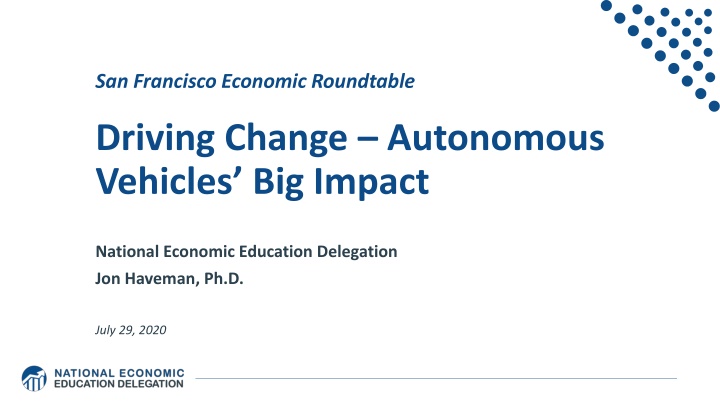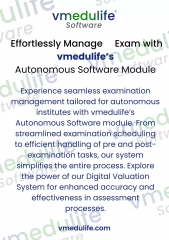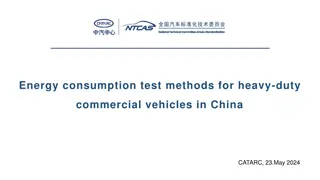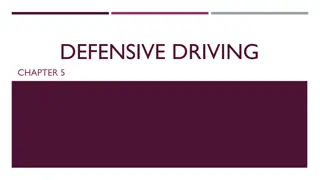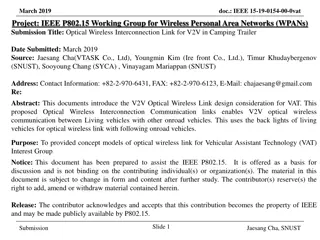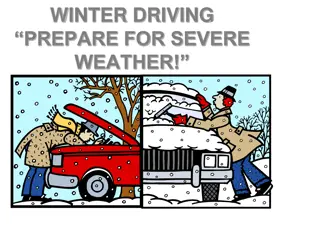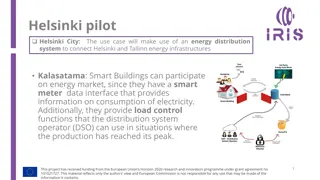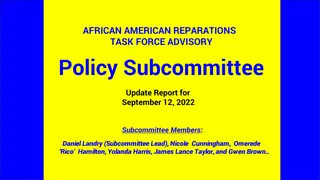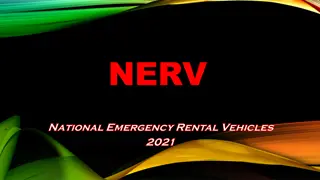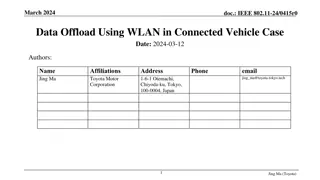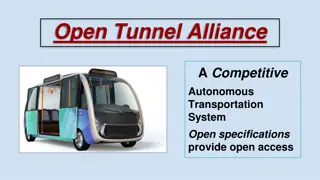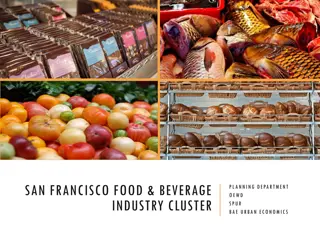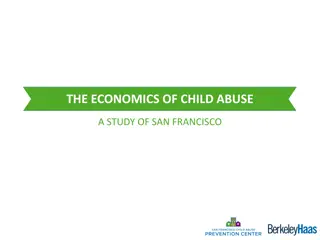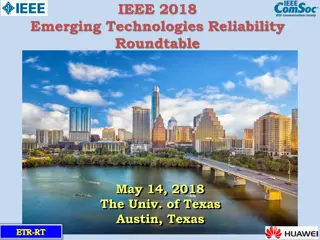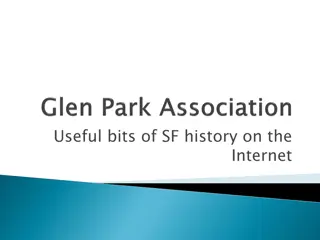San Francisco Economic Roundtable Driving Change with Autonomous Vehicles
The San Francisco Economic Roundtable, part of the National Economic Education Delegation, focuses on promoting understanding of policy issues in the United States using insights from professional economists. With key figures like Janet Yellen and Ben Bernanke involved, their nonpartisan presentations cover a variety of topics including healthcare economics, climate change, and economic inequality.
Download Presentation

Please find below an Image/Link to download the presentation.
The content on the website is provided AS IS for your information and personal use only. It may not be sold, licensed, or shared on other websites without obtaining consent from the author.If you encounter any issues during the download, it is possible that the publisher has removed the file from their server.
You are allowed to download the files provided on this website for personal or commercial use, subject to the condition that they are used lawfully. All files are the property of their respective owners.
The content on the website is provided AS IS for your information and personal use only. It may not be sold, licensed, or shared on other websites without obtaining consent from the author.
E N D
Presentation Transcript
San Francisco Economic Roundtable Driving Change Autonomous Vehicles Big Impact National Economic Education Delegation Jon Haveman, Ph.D. July 29, 2020
National Economic Education Delegation Vision - One day, the public discussion of policy issues will be grounded in an accurate perception of the underlying economic principles and data. Mission - NEED unites the skills and knowledge of a vast network of professional economists to promote understanding of the economics of policy issues in the United States. NEED Presentations - Are nonpartisan and intended to reflect the consensus of the economics profession. 2
Who Are We? Honorary Board: 54 members - 2 Fed Chairs: Janet Yellen, Ben Bernanke - 6 Chairs Council of Economic Advisers o Furman (D), Rosen (R), Bernanke (R), Yellen (D), Tyson (D), Goolsbee (D) - 3 Nobel Prize Winners o Akerlof, Smith, Maskin Delegates: 641+ members - At all levels of academia and some in government service - All have a Ph.D. in economics - Crowdsource slide decks - Give presentations Global Partners: 48 Ph.D. Economists - Aid in slide deck development 3
Available NEED Topics Include: Healthcare Economics The U.S. Economy Climate Change Immigration Economics Economic Inequality Housing Policy Economic Mobility Federal Budgets US Social Policy Federal Debt Trade and Globalization Black-White Wealth Gap Minimum Wage Autonomous Vehicles 5
Credits and Disclaimer This slide deck was authored by: - Jon Haveman, NEED This slide deck was reviewed by: - Ronald Fisher, Michigan State University - William F. Fox, University of Tennessee, Knoxville Disclaimer - NEED presentations are designed to be nonpartisan. - It is, however, inevitable that the presenter will be asked for and will provide their own views. - Such views are those of the presenter and not necessarily those of the National Economic Education Delegation (NEED). 6
Submitting Questions Please submit questions of clarification in the chat. - I will try to handle them as they come up. We will do a verbal Q&A once the material has been presented. Slides will be available from the NEED website tomorrow (https://needelegation.org/delivered_presentations.php) 7
Outline Where does the AV path lead? Transition Policy/Planning Issues Major Economic/Development Changes Environmental Implications
Growth Path McKinsey & Company
McKinsey isnt Always Spot On "In 1980, McKinsey & Company was commissioned by AT&T to forecast cell phone penetration in the U.S. by 2000. - The consultant s prediction, 900,000 subscribers, - was less than 1% of the actual figure, 109 Million. Professor Angel Lozano, 2014 11
Three Important Questions: 1. When will Transportation as a Service (TaaS) be available? 2. How quick will the transition be? 3. What will the future look like? 12
WHEN? What do the headlines say? NVIDIA to introduce level-4 enabling system by 2018 First autonomous Toyota to be available in 2020 Volkswagen expects first self driving cars on the market by 2019 Elon Musk now expects first fully autonomous Tesla by 2019, approved by 2021 Audi to introduce a self- driving car by 2020
40+ Corporations Working On Autonomous Vehicles 14
WHEN? What is possible? By 2025 (?) Potentially 95% of VMT by 2035. Last 5% is going to be very difficult to achieve. Is this possible? - Horses to cars: 10 years early 1900s - But adoption of EVs is so slow! - Adoption of AVs will be rapid.
Forecast Timing may be off. But the point is: RAPID ADOPTION! The Big Unknown 17
Fee-For-Service Autonomous TaaS Cruise: San Francisco driverless on June 1, 2022 Motional: Las Vegas in early 2023 More are surely coming soon . 19
Trucking Highly Fertile Ground Long haul trucking is likely the first place we will see it adopted. - Reduces costs associated with drivers. - End run around limits on hours of driving. Where does it stand? - Lots of trials underway. - TuSimple actively building a long haul network. - Waymo focused more on last mile/local delivery. 21
Actively Pursuing Autonomous Local Delivery Dominos Walmart Amazon CVS Pharmacy Stop and Shop Postmates Kroger 23
But, will it be: Heaven? OR Hell?
Hell Primarily individual private car ownership Much as today. Internal combustion engines Why Hell? Dramatically increased VMT and pollution. Potentially increased congestion Parking.
Two Adults and a Child: Morning Miles Parking Office 1 1 2 3 4 School Home 5 7 6 Office 2 And this is just the morning .. 28
Heaven Vehicle ownership will be very limited Private ownership for those with specialized vehicle needs. Fleet ownership will serve everybody else. Engines: electric Insurance: product liability Not clear when we will get there, but this is the likely model. 2030 for widespread adoption in many regions.
Why is this Heaven? Not only autonomous, but: - Shared - Connected - Green Far fewer cars in existence. - Better resource utilization. VMT could go up or down, but more productive than in Hell. Congestion effects unclear, but likely reduced. - Right-sized vehicles, platooning, sharing, V2V communication Minimal need for parking.
Transition Short term: Tesla model of highway autonomy - Level 2, adaptive cruise control. Medium term: - short period of personal vehicle ownership with level 3 capability. - introduction of independent private fleets Uber, Lyft, Google, nuTonomy, etc., with level 4/5 capability. Long term: - Personal vehicle ownership is largely a thing of the past.
Economics Drives Transition: Private Adoption dividend for private individuals - Eliminate car ownership o Ave annual cost of owning a car: $9,666 (2021) o Cost per mile will fall: $0.64 to $0.19 - Repurpose your garage o $50,000 from transition to bedroom Time recovery - 50% of the San Francisco Bay area workforce has a commute in excess of 30 minutes.
Economics Drives Transition: Public Economic and social costs associated with human drivers are enormous: - ACCIDENTS: o Drive 25% of congestion. o Result in 40,000 deaths. o And 2 million injuries. o 90+% caused by human error. - Increased productivity from not driving. - Costs of human drivers estimated at up to $1.3 TRillion each year
Potential Savings Morgan Stanley
Public Policy/Planning Issues Government buy-in: - Essential gov t must encourage progress - Difficult because of displacement issue Important transitional issues: - What infrastructure should be developed? - What to do about public transportation? - What to do with all of the parking spaces?
Responding to the coming changes: Transportation organizations must develop a forecast for adoption in their specific geography - San Francisco faster than Chicago - Chicago faster than Fresno - Fresno - faster than Kansas How does this affect the ROR calculation on projects? - Highway expansion? Public Transportation?
Encourage Change Mobility and equity considerations. - Elderly/disabled/impoverished Safety: only way to reduce traffic fatalities is by coordinated effort. Productivity: reduced congestion. Environment: speed transition to electric vehicles. These are all societal benefits that come about too slowly if the private market is left to itself.
Mobility and Equity Mobility - Handicapped - Elderly - Lower income Equity - Public Transportation often does not work well for low-income workers/residential workers o Does not go from residential to residential, but from residential to commercial
Environmental Implications Depends: Heaven or Hell Improved resource utilization More efficient travel - Right sized vehicles - Optimized routes - Reduced congestion - No searching for parking Increased VMT Cleaner technologies - Electric - Lighter vehicles Energy use of onboard electronics - Weight and functional Increased urban sprawl Bottom line: push governments at all levels to embrace and to implement policies deterring private vehicle ownership and zero passenger miles
Incentives Through Policy and Planning Allow vehicles equipped with ACC into HOV lanes - Eventual conversion of HOV lanes to ACC/AV lanes Allow ACC equipped vehicles to travel faster in HOV lanes Subsidize ACC upgrades - Arguably more concrete benefits than electric vehicles Sticks: higher costs of vehicle ownership - Registration fees, VMT taxes, etc. Note: ACC = Adaptive Cruise Control
Interim Summary Transition is coming very quickly! - Most reports are extremely conservative. - Apply generally, but faster in many regions. Very important to start incorporating AVs into planning now. - To realize the benefits of AVS. - Sacrifice expansion for maintenance.
What Changes Will This Bring? Disposable income Government finances Transportation Infrastructure Public transportation Employment Housing Parking Potentially dramatic improvements in infrastructure planning and maintenance - Data sharing and integration
Disposable Income Costs $9,666 to own a car. Will cost $3,000 to use TaaS. Net increase in disposable income of > $6,000. Spread across all households: more than $1 trillion in new spending in the economy. Major boost to economic activity. - CREATING JOBS!
Government Finances Government finances thrown for a loop: - Revenues up and down: o Parking revenue, tickets, traffic violation revenues o More commercial, retail and residential space - Less spending on road development - More (maybe less) spent on road maintenance o Fewer road miles o but perhaps more VMT
Transportation Demand for transportation will likely increase significantly: price falls, demand rises - Commutes may increase in distance, but not necessarily in duration - Zero passenger trips will arise o Deliveries At the same time, demand for roadway lane-miles will likely decrease - AVs make significantly more efficient use of space - Front to back and side to side
Infrastructure Focus of transportation infrastructure: - Currently on expansion - Will turn toward: o Maintenance TaaS providers push for fewer potholes? o Adding technology Stop lights will be digital as well as visual - Some will disappear: Signs!
Public Transportation Ambiguous implications for public transportation Demand may: - Shrink because of low cost of TaaS - Grow because last mile problem is solved Extensions may be added through contract with TaaS company
Cautionary Tale From Long Ago Automobiles impact on rail: The increasing dominance of cars was also felt by railway companies, which by June 1894 had to start making pricing concessions for transporting goods, even including free transport. - Samuel I. Schwartz, No One at the Wheel, 2018 50
